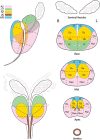The Current State of MR Imaging-targeted Biopsy Techniques for Detection of Prostate Cancer
- PMID: 29045233
- PMCID: PMC5673043
- DOI: 10.1148/radiol.2017161684
The Current State of MR Imaging-targeted Biopsy Techniques for Detection of Prostate Cancer
Abstract
Systematic transrectal ultrasonography (US)-guided biopsy is the standard approach for histopathologic diagnosis of prostate cancer. However, this technique has multiple limitations because of its inability to accurately visualize and target prostate lesions. Multiparametric magnetic resonance (MR) imaging of the prostate is more reliably able to localize significant prostate cancer. Targeted prostate biopsy by using MR imaging may thus help to reduce false-negative results and improve risk assessment. Several commercial devices are now available for targeted prostate biopsy, including in-gantry MR imaging-targeted biopsy and real-time transrectal US-MR imaging fusion biopsy systems. This article reviews the current status of MR imaging-targeted biopsy platforms, including technical considerations, as well as advantages and challenges of each technique. © RSNA, 2017.
Figures














References
-
- Siegel RL, Miller KD, Jemal A. Cancer statistics, 2015. CA Cancer J Clin 2015;65(1):5–29. - PubMed
-
- Djavan B, Margreiter M. Biopsy standards for detection of prostate cancer. World J Urol 2007;25(1):11–17. - PubMed
-
- Soloway MS, Soloway CT, Eldefrawy A, Acosta K, Kava B, Manoharan M. Careful selection and close monitoring of low-risk prostate cancer patients on active surveillance minimizes the need for treatment. Eur Urol 2010;58(6):831–835. - PubMed
-
- Noguchi M, Stamey TA, McNeal JE, Yemoto CM. Relationship between systematic biopsies and histological features of 222 radical prostatectomy specimens: lack of prediction of tumor significance for men with nonpalpable prostate cancer. J Urol 2001;166(1):104–109; discussion 109–110. - PubMed
Publication types
MeSH terms
LinkOut - more resources
Full Text Sources
Other Literature Sources
Medical

